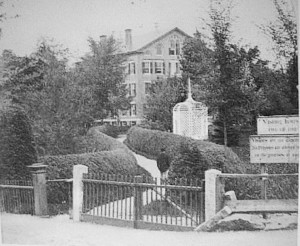The construction of an insane asylum was usually a welcome event for most towns or cities, since the work meant jobs and a continued money flow into the local economy. Newspapers had little but praise for these projects, as the Knoxville Daily Journal demonstrates: Continue reading
Author Archives: Carla Joinson
The Chronic Insane
Alienists stressed that the prompt treatment of insanity was imperative to a cure. They cautioned the public that it was far wiser to bring an afflicted person to an asylum for a cure as soon as possible, rather than let the patient languish at home for years until an asylum became a last resort. By that point, the disease might have too strong a hold and never be shaken. Continue reading
Evolution of Treatment for the Insane
Most modern readers would consider the mid-1800s a fairly rough and rugged period, inhabited by correspondingly rough and rugged individuals. However, changes in the treatment of insanity during this period point to the idea that people in the middle 1800s believed they had declined from the vigor of their ancestors. Continue reading
What Caused Insanity?
The causes for insanity that early alienists compiled can seem amusing–as well as appalling–to modern readers. Almost anything, from disappointment in love, financial reverses, over-study, improper diet, use of alcohol or tobacco, and masturbation could derail mental health, it seemed. However, most of these causes really stemmed from one primary cause: civilization. Continue reading
New Ideas
Food was not the only way to treat physical illnesses (see last few posts), though healthy eating may have been the least harmful way to ward off sickness.
The turn of the 20th century saw many innovations and experimental treatments by physicians who were working on new ways to help patients. The August, 1907 issue of The New Albany Medical Herald monthly journal ($1/year for a subscription) reported that:
“[Dr.?} Stuver has used galvanic electricity with splendid results in chronic rheumatism.
He uses a current of from 6 (?) to 20 mp. for a person, 20 minutes to a half-hour and says that the results are better if a thin layer of cotton, wet with a solution of cocaine, is placed under the positive pole.”

Tuberculosis Patients at J.N. Adam Memorial Hospital in Buffalo, NY, courtesy Edward G. Miller Library, University of Rochester Medical Center
Another article in the same issue concerned the treatment of tuberculosis. The writer, a Dr. Thos. P. Cheesborough, from Asheville, NC, noted that he usually received patients who were far along in the condition, due to their home physicians either missing the diagnosis entirely or being reluctant to tell their patients the bad news about their health.
Dr. Cheesborough then says, “One of the greatest disadvantages that I have found in treating this disease is that the poor unfortunate, when at last his disease has been diagnosed, and he has been sent from home and its comforts, has been advised by the home physician not to consult anyone here, but to exercise and drink whisky and to come home in a few months cured.”
Obviously, medical care could sometimes be hit or miss.
Importance of Asylum Gardens
Asylum gardens provided occupational therapy of a sort for patients who were physically able to work in them. Some patients truly enjoyed working in a small flower garden perhaps, or even an hour or two in a vegetable garden.
However, because some superintendents reported having to “force” patients to work outside, this so-called therapy obviously did not appeal to everyone. Continue reading
Searching for Canton Asylum Patients
This is an out-of-schedule post to ask for information about Canton Asylum patients transferred to St. Elizabeths in 1933, for a projected memorial. If you have any information about them, particularly about their lives before they were in Canton Asylum, we would both appreciate it. If you’d like to provide any details, you may simply reply to this post or send information to a private email at: deet84803@mypacks.net.
Joanna, Augusta
Bear, Frank
Charlie (only name)
Charley or Charles, Creeping
Dauphinais, Madeline
Ensign, Meda
Fairbanks, Richard
Jackson, Robert
Kalonuheskie, Edith
Rising Fire, Bessie
Shortwoman, Sarah
Tsinnjinnie, Mabel
Vigil, Fidel
Yazza, Zonna or Sonna
Yazzie, Hoskee
Thank you.
Preserving Food

William We-ah-lup Smoking Salmon, 1906, Tulalip Indian Reservation, courtesy University of Washington Libraries
Patients at the Canton Asylum for Insane Indians, though forced to eat a relatively poor diet of increasingly refined foods provided by the government, benefited from the fresh food and meat raised on the asylum grounds. However, there never seemed to be a sufficiency that allowed the kitchen staff to do much in the way of preserving this more nutritious food for winter use. Continue reading
Food Woes
Choices concerning Bran Flakes and Shredded Krumbles (see last post) weren’t the only food problems patients at the Canton Asylum for Insane Indians suffered. They, like most Native Americans, had already lost a basic underpinning of life–their traditional foods. This loss led to nutritional deficiencies and diseases that had never affected them before encountering the white man’s culture. Continue reading
And More Cereal
Cold, flaked cereals were not a part of traditional Native American diets, but many Native Americans on reservations doubtlessly ate them. So did the patients at the Canton Asylum for Insane Indians.
Both Sylvester Graham and John Harvey Kellogg (see last post) considered grains part of a healthy diet, and created products that reflected their beliefs. Whether or not Superintendent Harry Hummer also believed this or simply had to take what was issued to him through the Indian Office, he did serve this breakfast food at the asylum. Continue reading








